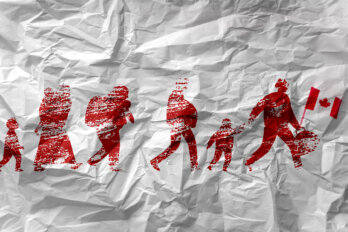Online Only: To view photos by Joan Latchford, click here. And read snippets of quotes from the 1970s on these “modern nomads.” The black, 1967 Ford station wagon pulled over to the shoulder of Highway 27, just before the Woodbine racetrack, and two wiry, clean-cut boys stepped out. Seventeen-year-old Art Adams and his friend Tom Croner slung their backpacks over their shoulders and waved to Art’s father as he drove away. Then they stuck out their thumbs to catch the first of many rides that would carry them to Mecca. It was July 1971, and it was outasight.
They joined 50,000–80,000 high school and university students, drop-outs, draft dodgers, freaks, heads, and hippies thumbing their way across the country that summer. Hitchhiking’s popularity among Canadian teenagers skyrocketed in the late sixties and early seventies. “More and more Canadians becoming wanderers,” warned a Toronto Star headline on the “modern nomads” in 1969. In Vancouver, teenagers rolled out sleeping bags in Stanley Park, English Bay, and Long Beach. In Banff, tourists complained to the rcmp about hippies sleeping in picnic shelters. One driver counted sixty young hitchhikers along the stretch from Sudbury to Sault Ste. Marie on a hot day that July.
By July 1970, there were so many teenagers on the road that Secretary of State Gerard Pelletier announced an emergency measure to turn thirteen Canadian armories into youth hostels for the 50,000 or more travelers on the road. In 1971, the year Art and Tom hit the road, Pelletier announced the transient youth phenomenon had reached epic proportions and launched a National Hostel Program. Part of the Trudeau Government’s effort to engage young radicals, more than $500,000 was doled out to youth groups and municipalities to open 116 makeshift hostels from Newfoundland to the Yukon. The program lasted until 1976 with up to 100,000 young things traveling each summer. From a set of old railway cars in Port-aux-Basques to a sixty-bed outfit in Whitehorse, transients ate and slept for “fifty cents a day or whatever they could afford.”
When the two boys got to Wawa a couple days later, Tom went on alone — he was in a rush to get back home to Vancouver. But for Art, the road was the thing. He took his time getting to Vancouver — a whole ten days — climbing into cars and trucks with a mailman, a housewife and her two young children, a truck driver and a Vietnam vet. He slept in a tent city in Wawa, a hockey rink in Thunder Bay, and a ditch outside Winnipeg. He shared a tin of sardines with a hobo and politely rejected advances from a trucker. He made it to Vancouver without spending a dime. It was the summer he grew his hair long. He kept it that way for the next twenty years.
It was the beginning of escape-en-masse and it was subsidized by the Canadian government. The country was fascinated, horrified, awestruck. In Prince Edward Island, where sixty percent of the population lived below the poverty line, resentment was ripe against “youth… bumming around on my tax money.” In June 1971, a group of Charlottetown residents locked elbows forming a human chain to block the RCMP from bringing tents and equipment to a proposed site for a tent hostel. In Montreal, Harry Chalratsiotis, who owned a restaurant next to a popular Montreal youth hostel, Habitat Durocher, threw cold buckets of water to scatter the hippies who hung out on his doorstep and scared off paying customers. Halifax Mayor Hedley Ivany readied to defend his city from free love: “I’m not anxious to see Point Pleasant Park, Victoria Park and the public gardens turned into a bedroom — and they won’t be,” he swore. In Vancouver, an army of denim-clad “street nurses” roamed youth hotspots “to try to arrest the tide of venereal disease, primarily gonorrhea” being spread by transient youth.
But the highlight of Art Adams’ trip wasn’t sex, pot, or rock n’ roll. “When I left Thunder Bay, I met a real, live hobo on the road,” he told me in a recent interview:
“He sorta’ took me under his wing, we shared a can of sardines and walked about thirty-two kilometres from Thunder Bay to Kakabeka Falls because we couldn’t get a ride. The sun was going down and the bum told me to go ahead and he went further down the road. He said it was the only way we were going to get along here, and if I got a ride, could I ask the driver to pick him up too? I got a ride in a Canada Post truck but he didn’t have room for anybody else, I asked him to stop the truck and I gave the hobo my can of sardines and the bread. He had nothing and he made a sacrifice for me. I had so much more than him.”
They were high on Kerouacian dreams. If these middle-class teenagers weren’t lucky enough to find authentic bums, they became them — dropping out and drifting — if just for a summer.
Sixteen-year-old Clifford J. Larabie, who hitchhiked from Cobalt, Ontario, to Alaska, advised Maclean’s readers, “Cheapness is… a factor but teenagers rarely thumb simply because they cannot afford some other means of transport. The experience is the thing. The weary, hungry-looking individual you pick up may often be carrying more cash than you are. He may say he doesn’t have much money — but then, how many of you would tell a hitchhiker that you have $300 or $400 in your back pocket?”
Young travelers idealized ‘the bum’. “I’ve heard people comment, ‘Gee he’s really cool. He really looks like he’s been around,’ in reference to some poor old guy trudging along Parliament,” wrote Jim Christy in a report on homelessness in Toronto for Saturday Night.
But professed anti-materialism was less substance than style — a one-way ticket to backpacking culture. “Two things distinguish the true hitcher from the stay-at-homes,” wrote Larabie. “One is the wind-tanned face and the confident, almost arrogant air of the traveler. The other is the knapsack — the hitcher’s status symbol.” Adams worked inventory at a bank to save for his trip, but he kept his traveler’s cheques carefully hidden away. “Who wants to be the rich kid from Etobicoke?” he said.
But a minority of transients — runaways, addicts, homeless, American draft dodgers, and deserters — were left behind at summer’s end. “My girlfriend and I come out this spring [to Vancouver] and we went to Wreck Bay,” said Joul, a seventeen-year old girl from Toronto. “We got into drugs pretty bad. She turned into a junkie and I was doing a lot of acid and chemicals so I came back and we went to the ‘Y[WCA]’. I found out I was pregnant so I stayed… for four months.”
Convinced that most youth on the road were more like Joul and less like Art, the Canadian Welfare Council conducted national surveys of transients for three summers beginning in 1969. By the third year, the council concluded — reluctantly — that transient youths were not truly harbourers of social unrest. “Perhaps what has really happened is that the myths which were held dear by transients and communities alike have been largely dispelled.”
It’s tempting to write the whole thing off as tens of thousands of self-stylized hippies having a lark on the government’s purse. “I was trying to remember this while I was in the hot tub last night,” Adams told me from London, Ontario, where he lives in semi-retirement. “I think at the Thunder Bay hostel it was $2.00 or $3.00 for the night or you could stay for free if you worked. And most people ‘worked,’ [which] usually meant something like sweeping the floor for ten minutes.”
Historian François Ricard calls youth culture in Canada in the sixties and seventies “an exercise in collective narcissism.” Describing the holy migration to music festivals in his book, Lyric Generation, Ricard writes, “It was as wanderers that came from all directions, backpacks on their shoulders and faith in their hearts… to witness the spectacle of their teeming and triumphant generation. They had come to see and adore themselves.”
But in post-war Canada, it took guts to announce to your parents that you were off for the summer — without job, without destination, with backpack. And claiming youth-only spaces in Canadian towns and cities were small victories in the war over public sanctuaries. “I detect a stiffening of opposition in the city over last summer,” said an Edmonton youth hostel worker in 1970, “Two long-haired kids over at our hostel last night had beer bottles thrown at them on the street.” Initially transients were billed by the media, government and social work organizations as a disease — labeled neurotic, psychotic, nomadic, and addicted to the road.
So I’ll leave cynicism to the expert. Instead, I’ll go with good old envy: it’s what led me to this story in the first place. How awesome is it that hundreds of thousands of teenagers just upped and traveled across the country, staying in youth-run hostels (like the former Bastille on the Plains of Abraham) for fifty cents a night? Now that is some sweet love.
Like the generations before them, and today’s Europe-on-a-shoestring backpackers, youth travelers have always been after the same things: freedom, adventure, alien surroundings — and each other. Bangkok’s Khao San Road pulses day and night with Western backpackers clad in standard bum-iform: fisherman’s pants, Tiger Beer tank tops, flip-flops and dreads/afro/messy hair. They’re out to see the country, sure; but full-moon parties DJed by international superstars — fueled by buckets of Thai whiskey and Red Bull with nay a Thai in sight — aren’t exactly the road to discovery.
Hitchhiking is no more dangerous today than it was forty years ago, but our fears are greater. Newspapers in the seventies carried reports of abducted, assaulted, raped, and murdered hitchhikers along with shrill warnings from politicians and worried parents. But incidents were few, and the rewards outweighed the risks.
Instead of discovering other countries, over half a million Canadian youths in the sixties and seventies discovered their own. With climate change threatening to ground our ability to fly, the boomers still throwing their weight around, and an increasingly diverse, and sometimes segregated, population — perhaps it’s time for teenagers to hit the Trans-Canada and carve out spaces of their own, again.




